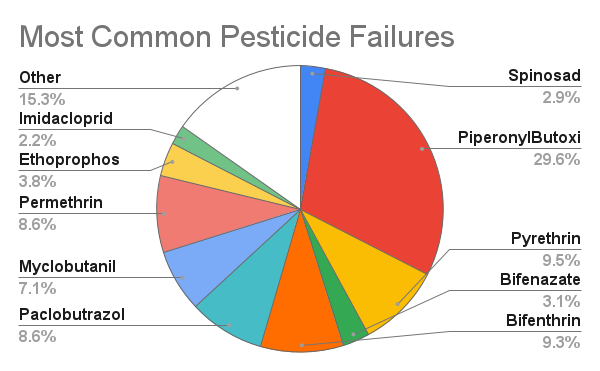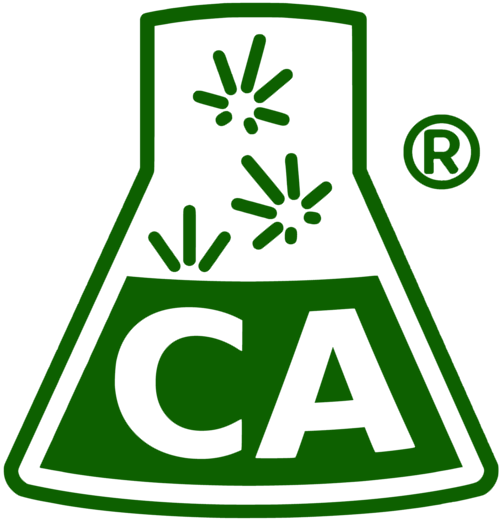Help! How did my cannabis become exposed to pesticides? I’ve never used that before…
Cannabis can be exposed to pesticides through a wide variety of sources. Detection at low levels -even levels above the action limits- is not necessarily evidence of wrongdoing. When considering how preventable human actions can be the cause of the exposure, we can reasonably group exposures into one of three groups:
- First, and most egregious, is deliberate application of a pesticide on a crop it is not approved for. When unapproved pesticides are applied to cannabis plants, even in the vegetative stages of development, it is likely to cause the final product to have residues at concentrations far above the action limits.
- Second is incidental exposure from neighboring sources, which can sometimes result in levels higher than you’d like. Pesticides are applied in many agricultural areas, home gardens, and even industrial areas. It is hard to find a place in our modern world where application of pesticides isn’t nearby. There are mitigation strategies that have proven to work in the organic produce industry to maintain compliance despite neighbors who spray. See below for answers.
- Third, and least troubling, is low-level incidental exposure. Pesticides of all types and levels of health risk are used in many ways, and very low levels (less than 0.1 ppm, or far lower) are present in the air we breathe, in the food we eat, and in the water we drink. It is an unfortunate reality of modern life, but not necessarily one that needs to negatively impact your products in particular.
Why did I fail Pesticides?
Samples fail for pesticides when any of the compounds listed in WAC 314-55-108 (Washington) were detected above the action level listed. This doesn’t mean that you sprayed the pesticides, or that you are at fault for having cannabis exposed to pesticides. If your company isn’t sure how the failing pesticide result came about, see question below “What can I do about it?” for more information.
What did I fail for? How did my cannabis become exposed to pesticides?

a pie chart of pesticide testing failures
Here are some of the most prevalent pest residue issues and where they often come from.
- Piperonyl Butoxide (PBO): PBO on its own is not an effective pesticide, however, PBO increases the efficiency of other pesticides when combined with them, and as a result it is an ingredient in many pesticide blends. PBO is allowed for use on cannabis in Washington state, and so many cultivators in Washington use it, but concentrates can still fail for high levels of PBO. If you have a PBO contamination problem it is quite possible that you or someone on your farm has used PBO containing products in the past. Even if not directly applied to the plants, PBO can linger and migrate for months after use. The most common products containing PBO are listed below, this list is not exhaustive:
- FOXFARM DONT BUG ME HOME & GARDEN INSECT SPRAY RTU
- BUSHDOCTOR FORCE OF NATURE INSECTICIDE
- PYRETHRUM TR TOTAL RELEASE INSECTICIDE
- DOKTOR DOOM TOTAL RELEASE FOGGER
- PYRONYL CROP SPRAY
- SPECTRACIDE TRIAZIDE INSECT KILLER /LANDSCAPES & GARDENS OUTDOOR FOGGER
- Pyrethrin: Pyrethrin is often mixed with PBO beacuse PBO makes pyrethrin more effective. Like PBO, pyrethrin is allowed for use on cannabis plants in Washington, but concentrates can still fail for high levels. If pyrethrin is in a concentrate then it was probably used correctly and was concentrated during the extraction process. Here are some tips:
- The product does not have a long half-life so do not use a week before harvest (This is an estimate based on research completed on other agricultural crops).
- If it is failing in flower, it is being used at either too high of a rate or too soon before harvest…. both practices should be changed.
- If the level in flower is more than 1/10th the action limit in concentrates, it may fail when concentrated.
- Bifenthrin is a commonly available pyrethroid insecticide. It is not approved for use on cannabis. There are only two ways it can show up on cannabis; drift or illegal use. Bifenthrin is most commonly used to combat ant and wasp infestations, so it isn’t likely to be used by a cannabis farmer for pest management of crops. Still, it is one of the most common failures in cannabis, so somehow it finds its way onto cannabis crops. Most often, the culprit is landscaping. A landlord or landscaper may have used bifenthrin around or on the property for wasp remediation. If those fumes travel -or drift- into the building or greenhouse it can easily cause a fail. Bifenthrin can be persistent and affect your crops for months after application.
What can I do about it?
- Make sure, if you are using products, you are only using ones on the WSDA allowed list and following recommended guidelines.
- Talk to your landlord or landscaper if you are failing for something like bifenthrin. Bifenthrin is a common ingredient in products used for ant and wasp mitigation. Your landlord or landscaper might be using it outside and there could have been contamination through vents or open doors.
- Check the labels on ALL products used in your facility and cross-check with the Approved Products list
- Check the limits of detection (LOD) on your COA for plant material to determine if they are low enough to account for concentration of the material, thus any potential pesticide residues. A general rule of thumb is any residue will concentrate by approximately a factor of 10.
- If the product is a concentrate, consider if remediation is a possible solution.
- You can use a pesticide swab kit to swab various areas in your facility and send the swabs in for testing. Contact us for details and to request a kit.
- Got drift from elsewhere? In Washington you can contact State Department of Agriculture (WSDA) to open an investigation. Pesticide drift from neighbors is considered a trespassing violation when it poses harm to humans, crops, or the environment. The department can help you find out where it’s coming from and seek remedy.
- WSDA Pesticide Compliance Toll-Free number: 1-877-301-4555
